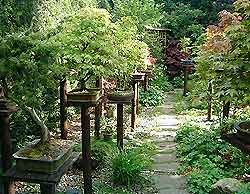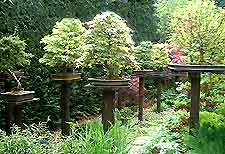Bonsai Trees
Watering

Early in spring, as bonsai begin to awaken from their dormancy, it is time to think about how regularly you intend to water your trees as the seasons progress. This will certainly be a factor when you prepare your soil mix for trees that require repotting.
Compost with more grit in the mix will obviously dry out faster, but grit is essential for good drainage. When potted in a gritty, free draining soil, it is difficult to over water a healthy bonsai tree that is growing well. However, if the mix is too free-draining and likely to dry out quickly, problems will be encountered and so a happy medium must be determined.
To some extent, trees can be 'trained' to thrive on more or less water at the beginning of spring. If you water sparingly as the trees begin to grow then you can carry on doing so throughout the summer. Conversely, if you start the growing season by watering heavily, then this is how you should continue during the year. It would certainly not be wise to suddenly change this routine as the tree will have become accustomed to its available intake. Also bear in mind that heavy watering tends to produce larger leaves and needles, so this should be considered when deciding your watering routine.

Growing in such small containers, with incredibly efficient roots systems and often dense canopies of foliage, it is hardly surprising that bonsai trees require regular watering as they grow. It is impossible to say how often a bonsai will need to be watered, because there are so many underlying factors that should be taken into account. These include the weather, position of the tree, soil mix, depth of pot and the species. Some trees such as pines will tolerate drier conditions far better than thirsty willows. For most species, an ideal time to water is just as the soil is almost dry, but of course this is not always practical or possible.
During the summer, a good routine is to water first thing in the morning and then check the trees in the evening, watering if necessary. A dull, overcast day with strong winds can be equally as drying as a hot, sunny day. Even if there has been rain, it often does not penetrate the dense foliage and wet the soil adequately, so don't be caught out and check routinely. Top dressing the top 2 cm (1 inch) of the soil mix with Japanese Akadama clay gives an indication of the water requirements. The particles change colour dramatically depending on the moisture content and trees that are beginning to dry out can be easily spotted.
If a tree does dry out, considerable damage can quickly result. This may not be fatal to the bonsai, but whole branches can die, causing many years work to be lost and the overall image may take years to recover to its former glory, if at all! Bear in mind that deciduous trees with leaves quickly show if they are stressed, by wilting. Normally this state is because the tree is dry and needs watering - quickly, although if waterlogged, root rot may be the cause. However, a dry juniper will not look as though it is suffering and it may be several weeks until you are aware of the resulting damage that has been caused, by which time it will probably be too late. For example, a spruce Christmas tree without roots, which is brought into the house, looks green for several weeks before its demise becomes apparent.
Watering with collected rain water is ideal, but tap water is perfectly acceptable in most cases. Wet the soil thoroughly so that water runs from the drainage holes, washing away any salts and deposits that may have built up at the bottom of the pot. Bonsai trees can be watered at any time of the day, but when in full sun, avoid splashing the foliage as this can sometimes cause scorching. In winter when trees require little water they will benefit by being given shelter from periods of endless heavy rain. However, at this time of the year trees can still dry out, so check regularly. In periods of cold, frosty weather, it is difficult to water a tree when dry soil is frozen. If needed, water in the morning so that the soil is not saturated should it become frosty during the night.
 Early in spring, as bonsai begin to awaken from their dormancy, it is time to think about how regularly you intend to water your trees as the seasons progress. This will certainly be a factor when you prepare your soil mix for trees that require repotting.
Early in spring, as bonsai begin to awaken from their dormancy, it is time to think about how regularly you intend to water your trees as the seasons progress. This will certainly be a factor when you prepare your soil mix for trees that require repotting. Growing in such small containers, with incredibly efficient roots systems and often dense canopies of foliage, it is hardly surprising that bonsai trees require regular watering as they grow. It is impossible to say how often a bonsai will need to be watered, because there are so many underlying factors that should be taken into account. These include the weather, position of the tree, soil mix, depth of pot and the species. Some trees such as pines will tolerate drier conditions far better than thirsty willows. For most species, an ideal time to water is just as the soil is almost dry, but of course this is not always practical or possible.
Growing in such small containers, with incredibly efficient roots systems and often dense canopies of foliage, it is hardly surprising that bonsai trees require regular watering as they grow. It is impossible to say how often a bonsai will need to be watered, because there are so many underlying factors that should be taken into account. These include the weather, position of the tree, soil mix, depth of pot and the species. Some trees such as pines will tolerate drier conditions far better than thirsty willows. For most species, an ideal time to water is just as the soil is almost dry, but of course this is not always practical or possible.